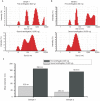Centrifugation: an important pre-analytic procedure that influences plasma microRNA quantification during blood processing
- PMID: 23601242
- PMCID: PMC3870851
- DOI: 10.5732/cjc.012.10271
Centrifugation: an important pre-analytic procedure that influences plasma microRNA quantification during blood processing
Abstract
Circulating microRNAs are robustly present in plasma or serum and have become a research focus as biomarkers for tumor diagnosis and prognosis. Centrifugation is a necessary procedure for obtaining high-quality blood supernatant. Herein, we investigated one-step and two-step centrifugations, two centrifugal methods routinely used in microRNA study, to explore their effects on plasma microRNA quantification. The microRNAs obtained from one-step and two-step centrifugations were quantified by microarray and TaqMan-based real-time quantitative polymerase chain reaction (Q-PCR). Dynamic light scattering was performed to explore the difference underlying the two centrifugal methods. The results from the microarray containing 1,347 microRNAs showed that the signal detection rate was greatly decreased in the plasma sample prepared by two-step centrifugation. More importantly, the microRNAs missing in this plasma sample could be recovered and detected in the precipitate generated from the second centrifugation. Consistent with the results from microarray, a marked decrease of three representative microRNAs in two-step centrifugal plasma was validated by Q-PCR. According to the size distribution of all nanoparticles in plasma, there were fewer nanoparticles with size >1,000 nm in two-step centrifugal plasma. Our experiments directly demonstrated that different centrifugation methods produced distinct quantities of plasma microRNAs. Thus, exosomes or protein complexes containing microRNAs may be involved in large nanoparticle formation and may be precipitated after two-step centrifugation. Our results remind us that sample processing methods should be first considered in conducting research.
Figures



References
-
- Schwarzenbach H, Hoon DS, Pantel K. Cell-free nucleic acids as biomarkers in cancer patients. Nat Rev Cancer. 2011;11:426–437. - PubMed
-
- Chen X, Ba Y, Ma L, Cai X, et al. Characterization of microRNAs in serum: a novel class of biomarkers for diagnosis of cancer and other diseases. Cell Res. 2008;18:997–1006. - PubMed
-
- Wong AM, Kong KL, Tsang JW, et al. Profiling of Epstein-Barr virus-encoded microRNAs in nasopharyngeal carcinoma reveals potential biomarkers and oncomirs. Cancer. 2012;118:698–710. - PubMed
Publication types
MeSH terms
Substances
LinkOut - more resources
Full Text Sources
Other Literature Sources
Miscellaneous
